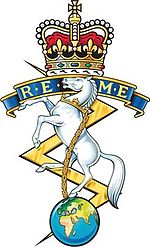 The Corps of Royal Electrical and Mechanical Engineers (REME; pronounced phonetically as “Reemee” with stress on the first syllable) is a corps of the British Army that maintains the equipment that the British Army uses.
The Corps of Royal Electrical and Mechanical Engineers (REME; pronounced phonetically as “Reemee” with stress on the first syllable) is a corps of the British Army that maintains the equipment that the British Army uses.
History
Prior to REME’s formation, maintenance was the responsibility of several different corps:
Royal Army Ordnance Corps—weapons and armoured vehicles
Royal Engineers—engineering plant and machinery, and RE motor transport
Royal Corps of Signals—communications equipment
Royal Army Service Corps—other motor transport
Royal Artillery-heavy weapons artificers
World War II’s increase in quantity and complexity of equipment exposed the flaws in this system. Pursuant to the recommendation of a committee William Beveridge chaired, the Corps of Royal Electrical and Mechanical Engineers was formed on 1 October 1942.
Phase I
Such a major re-organisation was too complex to be carried out quickly and completely in the middle of a world war. Therefore, the changeover was undertaken in two phases. In Phase I, which was implemented immediately, REME was formed on the existing framework of the RAOC Engineering Branch, strengthened by the transfer of certain technical units and tradesmen from the RE and RASC.
At the same time a number of individual tradesmen were transferred into REME from other corps. The new corps was made responsible for repairing the technical equipment of all arms with certain major exceptions.
REME did not yet undertake:
Those repairs which were carried out by unit tradesmen who were driver/mechanics or fitters in regiments and belonged to the unit rather than being attached to it.
Repairs of RASC-operated vehicles, which remained the responsibility of the RASC; each RASC Transport Company had its own workshop.
Repairs of RE specialist equipment, which remained the responsibility of the RE.
Phase II
In 1949, it was decided that “REME Phase II” should be implemented. This decision was published in Army Council Instruction 110 of 1949, and the necessary reorganisation was carried out in the various arms and services in three stages between July 1951 and January 1952. The main changes were:
The transfer to REME of most of the unit repair responsibilities of other arms (Infantry, Royal Artillery, Royal Armoured Corps etc.).The provision of Light Aid Detachments for certain units that had not possessed them under the old organisation.
The provision of new REME workshops to carry out field repairs in RASC transport companies. Maintenance of vessels of the RASC fleet whilst in port was given to the fleet repair branch, a civilian organisation who came under the R.E.M.E umbrella.
This organisation was also responsible for arranging and overseeing ship refits.
Sir Yes Sir Military Insignia provides most British Regiments Bespoke Rings, Cuff Links and Dog Tags. Furthermore, if we don’t have what you are looking for please visit out Custom Ring page and have us design exactly to your requirement.

